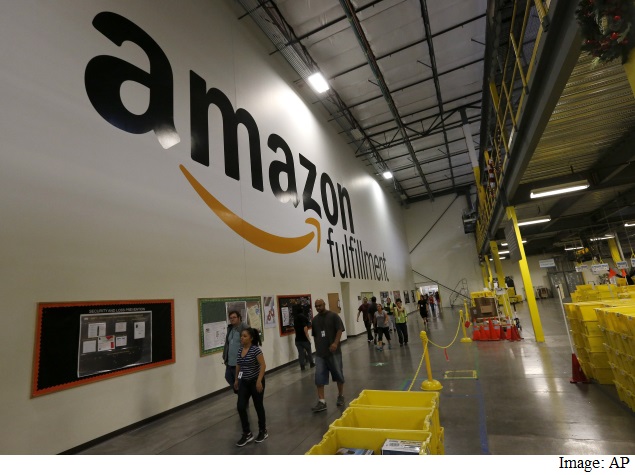- Home
- Internet
- Internet News
- Amazon Blasts US FAA for Slowness on Drone Regulation
Amazon Blasts US FAA for Slowness on Drone Regulation

E-commerce power Amazon.com blasted federal regulators on Tuesday for being slow to approve commercial drone testing, saying the United States is falling behind other countries in the potentially lucrative area of unmanned aviation technology.
Less than a week after the Federal Aviation Administration gave Amazon.com the green light to test a delivery drone outdoors, the company told US lawmakers that the prototype had already become obsolete while the company waited more than six months for the agency's permission.
"We don't test it anymore. We've moved on to more advanced designs that we already are testing abroad," said Paul Misener, Amazon.com's vice president for global public policy.
"Nowhere outside of the United States have we been required to wait more than one or two months to begin testing," Misener testified before the Senate Subcommittee on Aviation Operations, Safety and Security.
The Amazon.com case illustrates the frustrations of many industry representatives, who say the US regulatory process is not keeping up with rapidly developing drone technology that could generate new revenues and cost savings for a range of industries.
Ahead of Tuesday's hearing, the FAA sought to alleviate some of that frustration by announcing a new "blanket" approval that allows companies with exemptions from a US ban on commercial drone use to fly limited operations without seeking new approval for each project.
(Also See: Amazon's Twitch Resets Passwords Over Possible Security Breach)
The change affects only flights of up to 200 feet (61 metres) during daylight hours and within a drone operator's line of sight.
Seattle-based Amazon.com, the largest e-commerce company in the United States, wants to use drones to deliver packages to its customers over distances of 10 miles (16 km) or more, which would require drones to travel autonomously while equipped with technology to avoid collisions with other aircraft.
Misener said European and other international authorities have more "reasonable" approaches that recognise the potential economic benefits of commercial drone operations.
"This low level of government attention and slow pace are inadequate, especially compared to the regulatory efforts in other countries," Misener said, calling on regulators to begin planning now for drone systems capable of autonomous travel.
Margaret Gilligan, FAA's associate administrator for aviation safety, defended the pace of FAA drone actions on safety grounds, saying US airspace is more complex and more heavily traveled than that of other countries. She told the Senate panel that regulators could set new standards for autonomous drone operations within a year.
The FAA recently proposed rules that would lift the current ban on most commercial drone flights, but several restrictions attached would make package delivery and other business applications unfeasible.
Among other constraints, the proposed rules would limit commercial drones to an altitude of 500 feet (150 metres), allow flights only during daytime and require operators to keep the aircraft in sight at all times.
The agency does not expect to finalise the rules until late 2016 or early 2017, according to government officials. During this period, the current ban will stay in place; companies can apply for exemptions to use drones for specific business applications.
Gilligan said the FAA has granted more than 60 exemptions out of several hundred requests.
Meanwhile, Australia, Canada, France and the United Kingdom have progressed towards airspace integration and allow for commercial use, the Government Accountability Office (GAO) said in a report to the subcommittee.
Australia has granted operating certificates to 185 businesses, while several European countries have granted licenses to more than 1,000 operators, according to the report.
While the GAO said overseas restrictions are similar to those proposed by the FAA, it noted that France has begun to allow beyond-line-of-sight operations on a limited basis.
© Thomson Reuters 2015
For the latest tech news and reviews, follow Gadgets 360 on X, Facebook, WhatsApp, Threads and Google News. For the latest videos on gadgets and tech, subscribe to our YouTube channel. If you want to know everything about top influencers, follow our in-house Who'sThat360 on Instagram and YouTube.
Related Stories
- Samsung Galaxy Unpacked 2025
- ChatGPT
- Redmi Note 14 Pro+
- iPhone 16
- Apple Vision Pro
- Oneplus 12
- OnePlus Nord CE 3 Lite 5G
- iPhone 13
- Xiaomi 14 Pro
- Oppo Find N3
- Tecno Spark Go (2023)
- Realme V30
- Best Phones Under 25000
- Samsung Galaxy S24 Series
- Cryptocurrency
- iQoo 12
- Samsung Galaxy S24 Ultra
- Giottus
- Samsung Galaxy Z Flip 5
- Apple 'Scary Fast'
- Housefull 5
- GoPro Hero 12 Black Review
- Invincible Season 2
- JioGlass
- HD Ready TV
- Laptop Under 50000
- Smartwatch Under 10000
- Latest Mobile Phones
- Compare Phones
- Redmi Turbo 4
- Vivo Y200+
- Lava Yuva 2 5G
- OnePlus Ace 5
- OnePlus Ace 5 Pro
- Oppo A5 Pro 5G
- Vivo Y29 5G
- Honor Magic 7 RSR Porsche Design
- Asus Zenbook S 14
- MacBook Pro 16-inch (M4 Max, 2024)
- Honor Pad X9 Pro
- Honor Pad V9
- boAt Enigma Gem
- boAt Enigma Daze
- Sony 65 Inches Ultra HD (4K) LED Smart TV (KD-65X74L)
- TCL 55 Inches Ultra HD (4K) LED Smart TV (55C61B)
- Sony PlayStation 5 Pro
- Sony PlayStation 5 Slim Digital Edition
- Blue Star 1.5 Ton 3 Star Inverter Split AC (IC318DNUHC)
- Blue Star 1.5 Ton 3 Star Inverter Split AC (IA318VKU)

















